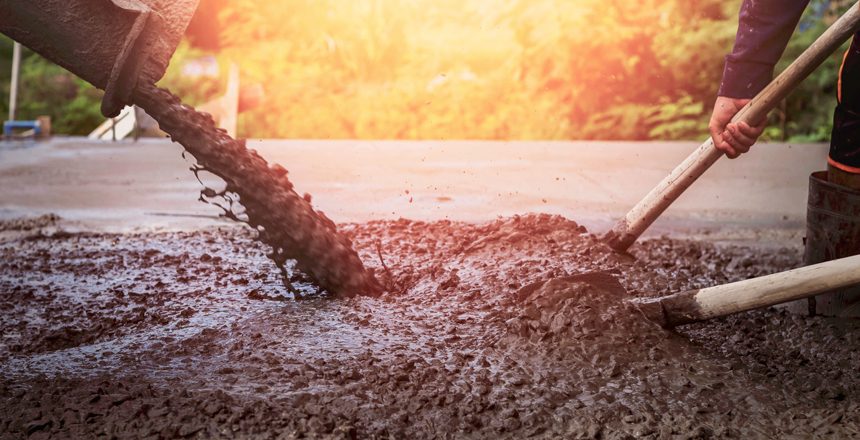Concrete is one of the most common materials used in construction due to its durability and versatility. But construction projects, big or small, usually can’t wait for ideal weather to pour concrete. That’s why learning how to work with this material in different weather conditions is vital, even when working on projects at home.
Experts suggest that the best conditions for pouring concrete are between 40 and 60 degrees Fahrenheit. If the weather is too hot or too cold, it can impact the chemical reactions needed for concrete to set and cure properly.
However, it is possible to successfully pour, set, and cure concrete in nearly all weather conditions. There are just a few extra steps and precautions you need to know, which we will cover in the rest of this article.
How Concrete Works
Before we get too far, let’s set the record straight about what concrete is, what it is not, and how it works. First, know that “cement” and “concrete” are not the same thing—cement is just one of the main ingredients in concrete.
Making concrete requires four key ingredients:
- Cement
- Sand (fine aggregate)
- Gravel (coarse aggregate)
- Water
The most critical component of the concrete solution is water, which is why it’s imperative to understand the role water plays in the pouring, setting, and curing of concrete.
Concrete sets and cures itself through chemical reactions. The water in the concrete does not evaporate; it becomes an essential part of the material. This chemical reaction is known as “hydration,” and it causes microscopic crystals to grow, develop, and interlock, creating a hard mass known as concrete.
Pouring Concrete in Hot Weather
High temperatures and direct sunlight can increase the chance of a concrete surface cracking before it has time to set. Surface cracking occurs when the moisture on the surface evaporates too quickly and causes concrete to set prematurely.
Concrete typically takes 4 hours to set at 80 degrees. A 10-degree increase will cause the concrete to set in 2.5 hours, and a 20-degree increase will cause the concrete to set in 1.5 hours. The faster the concrete sets, the greater the chance for premature setting and surface cracking.
Luckily, there are many ways to prepare for your concrete project to minimize the change of surface cracking and maximize your chance of proper concrete setting and curing. Here’s a checklist:
- Dampen the substrate with cool water before pouring the concrete
- Use cold mixing water to lower the temperature of the concrete
- Store your concrete materials in a cool, damp place
- Place the concrete early in the morning or late in the evening
- Hire adequate help to lay the concrete quickly to account for the short setting time
While pouring concrete in hot weather comes with challenges, it is still possible! If you follow the correct procedures, you will be able to pour concrete and get beautiful results.
Pouring Concrete in Cold Weather
If temperatures are significantly below 50 degrees, concrete takes much longer to set. If nighttime temperatures are below freezing, water in the concrete mix will freeze, expand, and create surface cracks.
So, before beginning your cold-weather concrete installation, consider taking necessary precautions to ensure that your concrete sets and cures properly:
- Use a heater to thaw any snow, ice, or frozen ground.
- Mix the cement with hot water
- Store all concrete materials in a warm place before use
- To avoid expansion and surface cracking, retain the framework around your pour area until the concrete thoroughly sets.
- Use additives in your concrete mixture to speed up set time
- Use products that are designed to set and cure quickly and properly
Additionally, a heated enclosure or an insulated blanket can be placed around the area to help keep the temperature around 50 degrees until it is fully set and cured. When using either of these methods, make sure that they are both wind and waterproof. It is also important that the heated enclosure or insulated blanket allow for proper ventilation.
Pouring Concrete in the Rain
The hardest part about pouring concrete in the rain is that you cannot always plan for the conditions. It is often an unfortunate surprise when it begins to rain while you’re pouring concrete.
Therefore, when working with concrete, always check your local forecast and be prepared for the possibility of rain. And consider the following to prepare for a worst-case scenario:
- Have plastic sheeting and waterproof materials on hand
- Understand the site conditions (some sites may be prone to flooding or have water-filled cavities)
- Go into the project knowing that you may need to reschedule the pour if the area is too wet
The biggest risk of laying concrete during rainy conditions is the amount of excess water that will seep into the concrete and cause it to weaken permanently. For this reason, never lay concrete on a surface that is saturated with or full of water.
If you decide to go forward and lay concrete in the rain. Follow these precautions to ensure proper setting:
- Ensure that the area has an adequate drainage system
- Use waterproof sheeting or tarps to create a tent-like structure over your work area
- Do not allow the rainwater to seep into the concrete before it is properly set
- Immediately after pouring and finishing your concrete, place plastic sheeting over the area.
There are enough things in life that keep us from projects around the house, but the weather doesn’t have to be one of them. Rain or shine, cold or hot, with preparation and the right tools, you can successfully pour concrete and enjoy your work for years to come.



